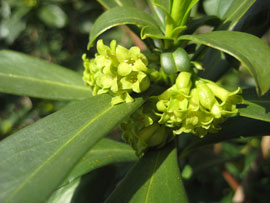
Spurge laurel (Daphne laureola) is a toxic, shade tolerant, evergreen shrub that has escaped from landscaped settings and is naturalizing in woodlands around the state. Spurge laurel is especially troublesome because it can grow right through the understory of our native forests. It can rapidly colonize shady sites to form dense stands, out-competing native vegetation and preventing new plants from generating. It reproduces from seed and also spreads underground from root sprouts. Birds and rodents ingest spurge laurel fruits, and spread seeds randomly making detection very difficult and allowing spurge laurel to spread undetected into natural areas.
Plants can begin flowering during their second year, but more often seed production will not occur for at least four years. The bark, leaves, and fruits of spurge laurel are toxic to humans, dogs, and cats. Handling the plant can cause contact dermatitis, so use caution when handling this species. Spurge laurel is noted as a significant threat to critically rare oak woodland ecosystems.
Identification
Spurge laurel is an evergreen, shade tolerant shrub that grows 2-4 feet high. Young branches are green, turning grey with age. Mature plants have many shoots, with most, if not all, originating very near the base of the plant. It has glossy, thick, oblong, dark green leaves that are spirally arranged and densely clustered near the tops of the shoots. The leaves are between 2-7 inches long and half an inch to 2 inches wide. It has inconspicuous, yellow-green flowers that bloom from late January to May and are quite fragrant, especially at night when they attract pollinators. The resulting poisonous berries start out green but turn black when ripe.
Report Sightings!
If you think you have found this plant please report it immediately. This plant is on our EDRR list, and we provide free control east of the Sandy River. Unfortunately, due to the abundance of this species in other areas, we cannot offer free control everywhere. Report a sighting!
More Photos
To see more photos of spurge laurel click here
